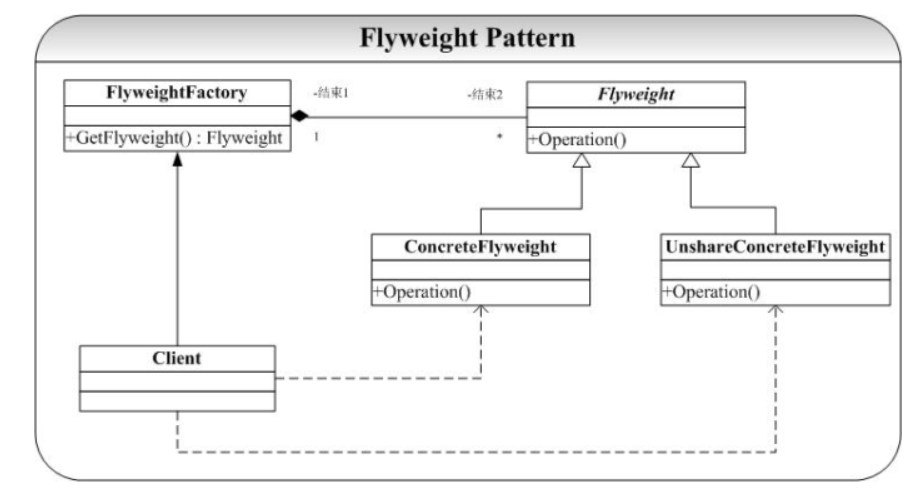结构型 - 享元(Flyweight)
享元模式(Flyweight Pattern): 利用共享的方式来支持大量细粒度的对象,这些对象一部分内部状态是相同的。 它让某个类的一个实例能用来提供许多"虚拟实例"。
抛砖引玉
在面向对象系统的设计何实现中,创建对象是最为常见的操作。
这里就有一个问题:如果一个应用程序使用了太多的对象,就会造成很大的存储开销。
特别是对于大量轻量级(细粒度)的对象,比如在文档编辑器的设计过程中,如果为没有字母创建一个对象的话,系统可能会因为大量的对象而造成存储开销的浪费。例如一个字母“ a”在文档中出现了100000 次, 而实际上可以让这一万个字母“ a” 共享一个对象。当然因为在不同的位置可能字母“ a” 有不同的显示效果(例如字体和大小等设置不同),在这种情况下,可以为将对象的状态分为“外部状态”和“ 内部状态”, 将可以被共享(不会变化)的状态作为内部状态存储在对象中, 而外部对象(例如上面提到的字体、 大小等)。 可以在适当的时候将外部对象作为参数传递给对象(例如,在显示的时候,将字体、大小等信息传递给对象)。
Flyweight 模式典型的结构图为:

从上图可以看出, Flyweight 模式中有一个类似 Factory 模式的对象构造工厂FlyweightFactory,当客户程序员( Client)需要一个对象时候就会向 FlyweightFactory 发出请求对象的消息 GetFlyweight()消息, FlyweightFactory 拥有一个管理、存储对象的“仓库”(或者叫对象池, vector 实现), GetFlyweight()消息会遍历对象池中的对象,如果已经存在则直接返回给 Client,否则创建一个新的对象返回给 Client。当然可能也有不想被共享的对象(例如结构图中的 UnshareConcreteFlyweight),但不在本模式的讲解范围,故在实现中不给出。
代码实现
#ifndef _FLYWEIGHT_H_
#define _FLYWEIGHT_H_
#include <string>
using namespace std;
class Flyweight
{
public:
virtual ~Flyweight();
virtual void Operation(const string &extrinsicState);
string GetIntrinsicState();
protected:
Flyweight(string intrinsicState);
private:
string _intrinsicState;
};
class ConcreteFlyweight : public Flyweight
{
public:
ConcreteFlyweight(string intrinsicState);
~ConcreteFlyweight();
void Operation(const string &extrinsicState);
protected:
private:
};
#endif //~_FLYWEIGHT_H_2
3
4
5
6
7
8
9
10
11
12
13
14
15
16
17
18
19
20
21
22
23
24
25
26
27
28
29
#include "Flyweight.h"
#include <iostream>
using namespace std;
Flyweight::Flyweight(string intrinsicState)
{
this->_intrinsicState = intrinsicState;
}
Flyweight::~Flyweight()
{
}
void Flyweight::Operation(const string &extrinsicState)
{
}
string Flyweight::GetIntrinsicState()
{
return this->_intrinsicState;
}
ConcreteFlyweight::ConcreteFlyweight(string intrinsicState) : Flyweight(intrinsicState)
{
cout << "ConcreteFlyweight Build....." << intrinsicState << endl;
}
ConcreteFlyweight::~ConcreteFlyweight()
{
}
void ConcreteFlyweight::Operation(const string &extrinsicState)
{
cout << "ConcreteFlyweight: 内 蕴[" << this->GetIntrinsicState() << "] 外 蕴[" << extrinsicState << "] " << endl;
}2
3
4
5
6
7
8
9
10
11
12
13
14
15
16
17
18
19
20
21
22
23
24
25
26
27
28
29
30
31
32
33
34
#ifndef _FLYWEIGHTFACTORY_H_
#define _FLYWEIGHTFACTORY_H_
#include "Flyweight.h"
#include <string>
#include <vector>
using namespace std;
class FlyweightFactory
{
public:
FlyweightFactory();
~FlyweightFactory();
Flyweight *GetFlyweight(const string &key);
protected:
private:
vector<Flyweight *> _fly;
};
#endif //~_FLYWEIGHTFACTORY_H_2
3
4
5
6
7
8
9
10
11
12
13
14
15
16
17
18
19
#include "FlyweightFactory.h"
#include <iostream>
#include <string>
#include <cassert>
using namespace std;
FlyweightFactory::FlyweightFactory()
{
}
FlyweightFactory::~FlyweightFactory()
{
}
Flyweight *FlyweightFactory::GetFlyweight(const string &key)
{
vector<Flyweight *>::iterator it = _fly.begin();
for (; it != _fly.end(); it++)
{
//找到了,就一起用, ^_^
if ((*it)->GetIntrinsicState() == key)
{
cout << "already created by users...." << endl;
return *it;
}
}
Flyweight *fn = new ConcreteFlyweight(key);
_fly.push_back(fn);
return fn;
}2
3
4
5
6
7
8
9
10
11
12
13
14
15
16
17
18
19
20
21
22
23
24
25
26
27
28
29
#include "Flyweight.h"
#include "FlyweightFactory.h"
#include <iostream>
using namespace std;
int main(int argc, char *argv[])
{
FlyweightFactory *fc = new FlyweightFactory();
Flyweight *fw1 = fc->GetFlyweight("hello");
Flyweight *fw2 = fc->GetFlyweight("world!");
Flyweight *fw3 = fc->GetFlyweight("hello");
return 0;
}2
3
4
5
6
7
8
9
10
11
12
13
[root@VM-16-6-centos Flyweight]# ./FlyweightTest
ConcreteFlyweight Build.....hello
ConcreteFlyweight Build.....world!
already created by users....
2
3
4
5
代码说明
Flyweight 模式在实现过程中主要是要为共享对象提供一个存放的“仓库”(对象池)。
这里是通过 C++ STL 中 Vector 容器, 当然就牵涉到 STL 编程的一些问题( Iterator 使用等)。另外应该注意的就是对对象“仓库”(对象池) 的管理策略(查找、 插入等), 这里是通过直接的顺序遍历实现的,当然我们可以使用其他更加有效的索引策略,例如 Hash 表的管理策略,当时这些细节已经不是 Flyweight 模式本身要处理的了。
讨论
在 State 模式和 Strategy 模式中会产生很多的对象,因此可以通过 Flyweight模式来解决这个问题。